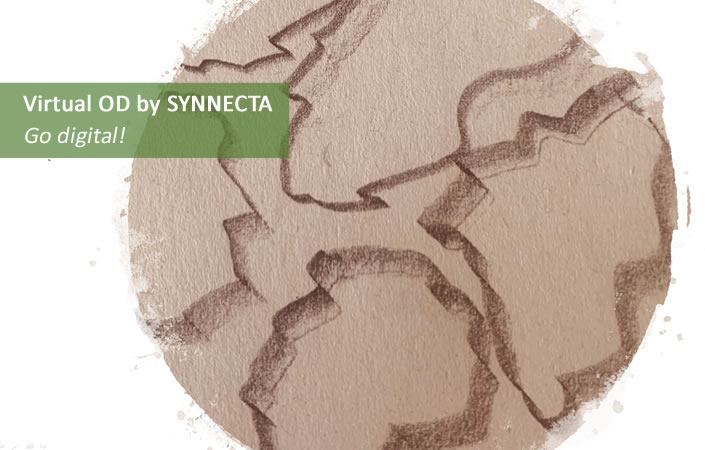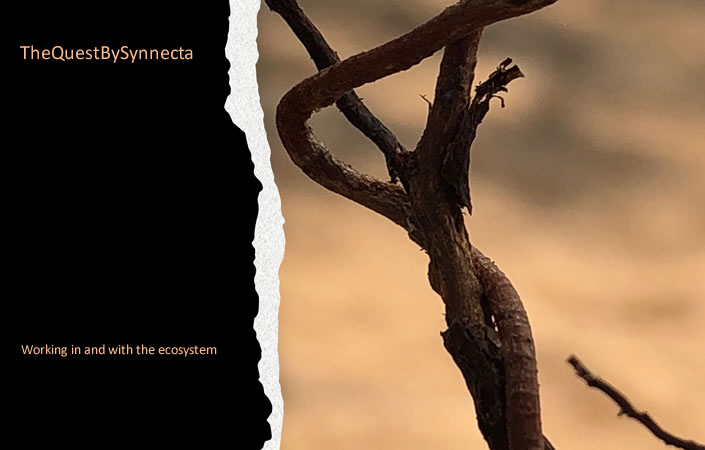Virtual OD by SYNNECTA – Go digital!

The digital world is a great source of new potential for organizations to foster a cultural change that is more democratic and more tuned into the future in order to address the challenges of an increasingly complex and dynamic world. In future, culture will be even more important in organizations. Culture fills gaps that cannot be bridged by structures and traditional processes alone.
Virtual organization development – Virtual OD by SYNNECTA – provides sustainable support to this aspect.
Cultural change aims to strengthen engagement, heighten performance, improve collaboration, make effective use of diversity and become more agile. It aims for the sustainable development of an organization. Only those organizations that engage in such continuous development will in the future be able to deal with change swiftly and appropriately and maintain long-term success.
Cultural change can take place from two directions
Approach 1: Central perspective – one guiding theme creates a pervasive common notion that is delivered ‘top down’ in order to integrate differences (different characteristics, metaphors, …). Further along, we see the development of islands that network self-sufficiently and influence the central pervasive message.
Approach 2: Synchronous-lateral perspectives – Useful aspects emerge automatically. Peripheral perspectives emerge laterally and enable the required multi-perspective viewpoint from the beginning. Resonance and successful action foster the emergence of new structures, which in turn resonate again and thereby reinforce each other (spiralling development) – self-sufficient organizing.
This is where Virtual OD by SYNNECTA opens up great opportunities.
Both approaches take place in conjunction in everyday Organizational Development, but are given different emphasis.
Employee community and identification with the organization serve as social glue. An organization’s strong core identity prevents it drifting apart. Communication within a continuous dialogue that provides emotional touchpoints is an essential guiding element here.
Organizational Development today: limits and challenges
Cultural transformations traditionally begin at the »centre«, meaning from an organization’s headquarters and spreading from this »epicentre« to other areas and through the entire organization in order to become »global«. The direction of change therefore goes from »central« to »local«.
In this process, thinking and acting come from the central perspective of the headquarters from the beginning. This means that the process is asymmetrical from the very start, with a decline from the centre to the periphery. Consequences can include:
- Lack of identification in the peripheral areas that are not part of the centre.
- Weaker acceptance and lacking commitment.
- Difficulties guiding the transformation on global and international levels.
- Varying depths of effect and speeds of implementation between centre and regions.
- The differences between centre and regions stay in place and may even be reinforced or increased (insider/outsider thinking).
- Important perspectives and potential from the periphery is not sufficiently included and utilized.
Successful cultural development always includes self-organized dynamics and therefore requires an approach »across the field« that departs from the notions of »top-down« and »bottom-up«, which reinforce a hierarchical mindset. The real force of renewal is therefore found in the periphery. The digital sphere provides an opportunity to strengthen or improve these aspects.

Digitalization can foster a new Organizational Development
Any organization essentially has the implicit knowledge to be sustainable for the future. However, it is often not understood how to explicitly use this knowledge. Virtual OD by SYNNECTA shifts the dynamics from central to local. At the same time, it provides an opportunity to leave to dominant notion of »top-down« and »bottom-up« behind. Organizational Development at eye level!
The three classic levers of Organizational Development are creating meaning, changing patterns and establishing commonalities. These three levers can be expanded by Virtual OD by SYNNECTA. It allows for the guiding theme to be disseminated with greater conviction (see approach 1), but even more importantly, to design self-sufficient organization more effectively (see approach 2).
The greater efficacy of virtual organizational development is mostly created by the following aspects:
- Time and space are opened, so that simultaneous activity is possible and asymmetries are eliminated.
- Synchronous and asynchronous events/communication/collaboration take place at a global level.
- Fast and high degree of networking among people in the digital space.
- The power of weak joints. Weak joints are the basis of prolific cooperation. Virtual OD by SYNNECTA uses the power of weak joints.
- More outcome thanks to focussed collaboration.
- A greater degree of self-sufficient organization, stronger interaction and involvement.
- More effective dynamics permit themes to spread virally faster.
- Creation of virtual communities (of practice).
- Greater use of creative tension through multi-perspective working in the digital sphere (using diversity).
What moves you?
- Remote work will stay with us!
- How will the dominant position of the headquarters be reduced?
- How do we achieve greater and more sustainable employee engagement?
Contact us!

